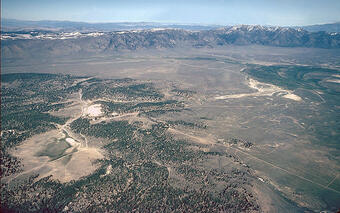The broad depression of Long Valley Caldera that we see today is much shallower and a little larger in diameter than it was immediately after its formation about 760,000 years ago.

The caldera was partially filled by pyroclastic flows and tephra (Bishop Tuff) during the catastrophic eruption and also by many subsequent episodes of volcanic activity. The Bishop Tuff is overlain by more than 700 m (2,300 ft) of sediments that were deposited in the caldera lake during a 600,000 year postcaldera interval. The original topographic boundary of the caldera walls has been enlarged by landslides, glaciation, and rapid erosion.
The volcanic rocks of both Bald Mountain and Glass Mountain were erupted before the caldera-forming eruption. Bald Mountain consists of lava domes and flows that were erupted between 3.8 and 3.5 million years ago. Glass Mountain consists of a 1,000 m sequence of lava domes, flows, and nonwelded pyroclastic flows that were erupted between 2.1 and 0.8 million years ago.

Lookout Mountain and the Glass Creek flow were erupted after the caldera-forming eruption. Lookout Mountain was erupted within about 100,000 years of the caldera-forming eruption. Glass Creek flow was erupted about 600 years ago during the Inyo eruptions.
The surface of the flat lowlands east of the resurgent dome is layered with sediments that were deposited when a large lake filled the caldera. Scientists have identified terraces and standlines from the former lake both along the eastern caldera wall and on the flanks of the resurgent dome. During the early life of the lake, glaciers flowing into it from the Sierra Nevada generated icebergs that drifted across the lake. The icebergs carried large granite rocks eroded from the Sierra Nevada and deposited them on the flanks of the resurgent dome, which stood as an island, and on the lake terraces on the east caldera wall.
The broad depression of Long Valley Caldera that we see today is much shallower and a little larger in diameter than it was immediately after its formation about 760,000 years ago.

The caldera was partially filled by pyroclastic flows and tephra (Bishop Tuff) during the catastrophic eruption and also by many subsequent episodes of volcanic activity. The Bishop Tuff is overlain by more than 700 m (2,300 ft) of sediments that were deposited in the caldera lake during a 600,000 year postcaldera interval. The original topographic boundary of the caldera walls has been enlarged by landslides, glaciation, and rapid erosion.
The volcanic rocks of both Bald Mountain and Glass Mountain were erupted before the caldera-forming eruption. Bald Mountain consists of lava domes and flows that were erupted between 3.8 and 3.5 million years ago. Glass Mountain consists of a 1,000 m sequence of lava domes, flows, and nonwelded pyroclastic flows that were erupted between 2.1 and 0.8 million years ago.

Lookout Mountain and the Glass Creek flow were erupted after the caldera-forming eruption. Lookout Mountain was erupted within about 100,000 years of the caldera-forming eruption. Glass Creek flow was erupted about 600 years ago during the Inyo eruptions.
The surface of the flat lowlands east of the resurgent dome is layered with sediments that were deposited when a large lake filled the caldera. Scientists have identified terraces and standlines from the former lake both along the eastern caldera wall and on the flanks of the resurgent dome. During the early life of the lake, glaciers flowing into it from the Sierra Nevada generated icebergs that drifted across the lake. The icebergs carried large granite rocks eroded from the Sierra Nevada and deposited them on the flanks of the resurgent dome, which stood as an island, and on the lake terraces on the east caldera wall.

